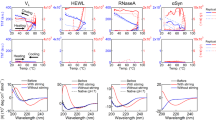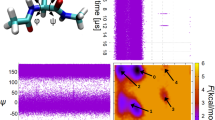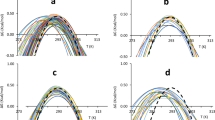Abstract
Many small proteins seem to fold by a simple process explicable by conventional chemical kinetics and transition-state theory. This assumes an instant equilibrium between reactants and a high-energy activated state1. In reality, equilibration occurs on timescales dependent on the molecules involved, below which such analyses break down1. The molecular timescale, normally too short to be seen in experiments, can be of a significant length for proteins. To probe it directly, we studied very rapidly folding mutants of the five-helix bundle protein λ6–85, whose activated state is significantly populated during folding. A time-dependent rate coefficient below 2 µs signals the onset of the molecular timescale, and hence the ultimate speed limit for folding2. A simple model shows that the molecular timescale represents the natural pre-factor for transition state models of folding.
This is a preview of subscription content, access via your institution
Access options
Subscribe to this journal
Receive 51 print issues and online access
$199.00 per year
only $3.90 per issue
Buy this article
- Purchase on Springer Link
- Instant access to full article PDF
Prices may be subject to local taxes which are calculated during checkout




Similar content being viewed by others
References
Berne, B. J. in Activated Barrier Crossing: Applications in Physics, Chemistry and Biology (eds Hänggi, P. & Fleming, G. R.) 82–119 (World Scientific, Singapore, 1993)
Hagen, S. J., Hofrichter, J., Szabo, A. & Eaton, W. A. Diffusion-limited contact formation in unfolded cytochrome c: Estimating the maximum rate of protein folding. Proc. Natl Acad. Sci. USA 93, 11615–11617 (1996)
Lapidus, L. J., Eaton, W. A. & Hofrichter, J. Measuring the rate of intramolecular contact formation in polypeptides. Proc. Natl Acad. Sci. USA 97, 7220–7225 (2000)
Bieri, O. et al. The speed limit for protein folding measured by triplet–triplet energy transfer. Proc. Natl Acad. Sci. USA 96, 9597–9601 (1999)
Yeh, I. C. & Hummer, G. Peptide loop-closure kinetics from microsecond molecular dynamics simulations in explicit solvent. J. Am. Chem. Soc. 124, 6563–6568 (2002)
Thirumalai, D. Time scales for the formation of the most probable tertiary contacts in proteins with applications to cytochrome C. J. Phys. Chem. B 103, 608–610 (1999)
Portman, J. J., Takada, S. & Wolynes, P. G. Microscopic theory of protein folding rates. II. Local reaction coordinates and chain dynamics. J. Chem. Phys. 114, 5082–5096 (2001)
Portman, J. J., Takada, S. & Wolynes, P. G. Microscopic theory of protein folding rates. I. Fine structure of the free energy profile and folding routes from a variational approach. J. Chem. Phys. 114, 5069–5081 (2001)
Hagen, S. J., Hofrichter, J. & Eaton, W. A. Rate of intrachain diffusion of unfolded cytochrome c. J. Phys. Chem. B 101, 2352–2365 (1997)
Schuler, B., Lipman, E. A. & Eaton, W. A. Probing the free-energy surface for protein folding with single-molecule fluorescence spectroscopy. Nature 419, 743–747 (2002)
Gruebele, M., Sabelko, J., Ballew, R. & Ervin, J. Laser temperature jump induced protein refolding. Acc. Chem. Res. 31, 699–707 (1998)
Metzler, R., Klafter, J. & Jortner, J. Hierarchies and logarithmic oscillations in the temporal relaxation patterns of proteins and other complex systems. Proc. Natl Acad. Sci. USA 96, 11085–11089 (1999)
Burton, R. E., Huang, G. S., Daugherty, M. A., Calderone, T. L. & Oas, T. G. The energy landscape of a fast-folding protein mapped by Ala → Gly substitutions. Nature Struct. Biol. 4, 305–309 (1997)
Ghaemmaghami, S., Word, J. M., Burton, R. E., Richardson, J. S. & Oas, T. G. Folding kinetics of a fluorescent variant of monomeric lambda represssor. Biochemistry 37, 9179–9185 (1998)
Myers, J. M. & Oas, T. G. Contribution of a buried hydrogen bond to lambda repressor folding kinetics. Biochemistry 38, 6761–6768 (1999)
Chang, I. J., Lee, J. C., Winkler, J. R. & Gray, H. B. The protein-folding speed limit: intrachein diffusion times set by electron transfer rates in denatured Ru(NH3)5(His-33)-Zn-cytochrome c. Proc. Natl Acad. Sci. USA 100, 3838–3840 (2003)
Silow, M. & Oliveberg, M. Transient aggregates in protein folding are easily mistaken for folding intermediates. Proc. Natl Acad. Sci. USA 94, 6084–6086 (1997)
Sabelko, J., Ervin, J. & Gruebele, M. Observation of strange kinetics in protein folding. Proc. Natl Acad. Sci. USA 96, 6031–6036 (1999)
Garcia-Mira, M. M., Sadqi, M., Fischer, N., Sanchez-Ruiz, J. M. & Muñoz, V. Experimental identification of downhill protein folding. Science 298, 2191–2195 (2002)
Silow, M. & Oliveberg, M. High-energy channeling in protein folding. Biochemistry 36, 7633–7637 (1997)
Pappenberger, G., Saudan, C., Becker, M., Merbach, A. E. & Kiefhaber, T. Denaturant-induced movement of the transition state of protein folding revealed by high-pressure stopped-flow measurements. Proc. Natl Acad. Sci. USA 97, 17–22 (2002)
Snow, C. D., Nguyen, H., Pande, V. S. & Gruebele, M. Absolute comparison of simulated and experimental protein-folding dynamics. Nature 420, 102–106 (2002)
Mayor, U. et al. The complete folding pathway of a protein from nanoseconds to microseconds. Nature 421, 863–867 (2003)
Ervin, J., Sabelko, J. & Gruebele, M. Submicrosecond real-time fluorescence detection: application to protein folding. J. Photochem. Photobiol. B 54, 1–15 (2000)
Acknowledgements
We thank T. Oas for suggesting many helpful lambda repressor mutations. This work was supported by an Alumni Scholarship and a Camille Dreyfus Teacher–Scholar Award to M.G.
Author information
Authors and Affiliations
Corresponding author
Ethics declarations
Competing interests
The authors declare that they have no competing financial interests.
Supplementary information
Rights and permissions
About this article
Cite this article
Yang, W., Gruebele, M. Folding at the speed limit. Nature 423, 193–197 (2003). https://doi.org/10.1038/nature01609
Received:
Accepted:
Issue Date:
DOI: https://doi.org/10.1038/nature01609
This article is cited by
-
Protein folding rate evolution upon mutations
Biophysical Reviews (2023)
-
Hyperpolarized water as universal sensitivity booster in biomolecular NMR
Nature Protocols (2022)
-
Using azobenzene photocontrol to set proteins in motion
Nature Reviews Chemistry (2021)
-
Transition path times of coupled folding and binding reveal the formation of an encounter complex
Nature Communications (2018)
-
Focused clamping of a single neuronal SNARE complex by complexin under high mechanical tension
Nature Communications (2018)
Comments
By submitting a comment you agree to abide by our Terms and Community Guidelines. If you find something abusive or that does not comply with our terms or guidelines please flag it as inappropriate.



